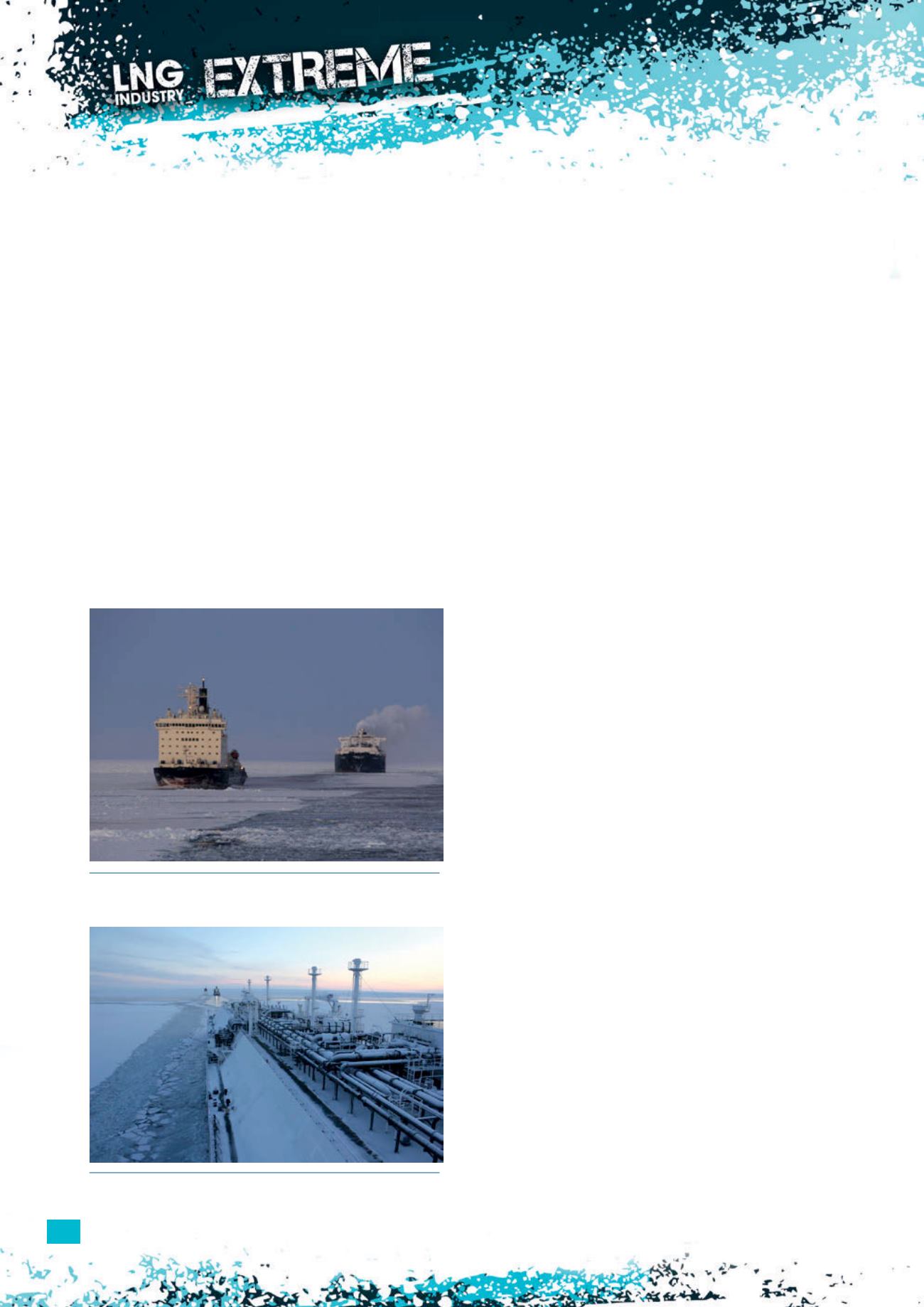
38
What kind of ice-breaking LNG
and condensate tankers would be
needed?
The project has carefully evaluated the design of existing
vessels navigating in the Polar regions, and especially those
operating for a number of years in Russian projects, such
as the containerships for Dudinka, and the shuttle tankers
for Varandey and Prirazlomnoye along the northern coast.
The main distinctive feature of the project’s ice-breaking
LNG carriers and condensate tankers would be their ability
to undertake ‘double-acting’ or ‘pushing-pulling’ operations.
This means that the carriers will be able to sail both ahead
and astern, having an optimised open water ice-breaking bow
and an optimised ice-breaking stern. The carrier will enter the
ice area bow first until the ice conditions become too difficult.
Then, the carrier will turn around and move stern first.
Ice class notation
With reference to the Russian Maritime Register of Shipping
(RMRS), the ice-class notation for a merchant vessel to
operate year-round along all of the seas of the NSR should
be Arc9. There is no existing merchant vessel built to this
notation, and the maritime routes are too harsh in the eastern
part of NSR during winter, even for the nuclear ice-breakers
from Atomflot, for a reliable maritime export route. The
rules from the RMRS stipulate the use of Arc7 notation as a
minimum for independent navigation (without the assistance
of an ice-breaker) all year round, when sailing to the West
from the Yamal LNG terminal in Sabetta. Hence, the project’s
LNG carrier is designed for this ice class notation, but with
additional requirements, such as similar reinforcements
of the hull for bow and stern, and reinforcement of the
double bottom (derived from Arc8 notation), to address the
navigation in shallow waters in the Ob river.
Main characteristics of the ship
The reference in-service ships have smaller sizes (lengths of
160 – 250 m and breadths of less than 35 m). To be economic,
the LNG carriers have to be larger and close to conventional
LNG carriers’ size (this also applies for transshipment purposes).
Starting from a generic hull with a 205 000 m
3
cargo capacity
(Q-Flex size LNG carrier), and hybrid propulsion designed by
Aker Arctic (AARC), the ice model tests have shown that the
manoeuvrability in ice was limited due to the length of the
ship’s flat body. The results were much more encouraging when
using a 170 000 m
3
size, which is the chosen solution.
Various ice and open water model tests have also
confirmed that a moderate ice bow is the solution for
mitigating the behaviour and performance of the ship in open
and ice-laden waters, and for minimising the risks in
operations (assessment of ice thickness for anticipation of the
stern mode). On one hand, a bulbous bow has good
performances in open seas, but limited capability in level ice,
enabling the shift for astern mode rapidly. On the other hand,
a moderate ice bow performs well in ice, but is less efficient in
open water in terms of fuel consumption and with regard to
the ‘slamming’ effect. Moreover, the stern design shape was
influenced by the selection of a triple azimuthing thruster
lay-out for propulsion.
The propulsion and machinery layout
The conventional propulsion of LNG carriers (fixed shafts and
rudders) would be limiting in the case of a double-acting ship;
azimuthal thrusters need to be fitted. During model tests,
various configurations were considered (two pods, three
pods or hybrid, four pods), together with the optimised form
of the respective stern. The final solution was a three azipod
configuration, which provides redundancy and enhanced
manoeuvrability in ice.
This option requires the impact of the ice loads on the
behaviour of the propellers to be checked, especially when
the propellers are stuck by ice, where the need for an
overtorque of 180% and the installation of loadbanks was
investigated. This is to mitigate the impact of the ice on the
entire drive chain (tri-fuel diesel electric engines) and to avoid
recurring switching between gas diesel modes. Moreover, the
development of a new azipod with a higher capacity (15 MW
Arc7), compared to the existing and proven pods of 13 MW,
was deemed necessary.
Figure 5.
First transit of a conventional LNG carrier along the
NSR with nuclear ice-breakers (‘LNGC Ob River’ courtesy of
Dynagas).
Figure 4.
Nuclear ice-breaker escorting a tanker along the
Northern Sea Route (NSR) (courtesy of Atomflot).


